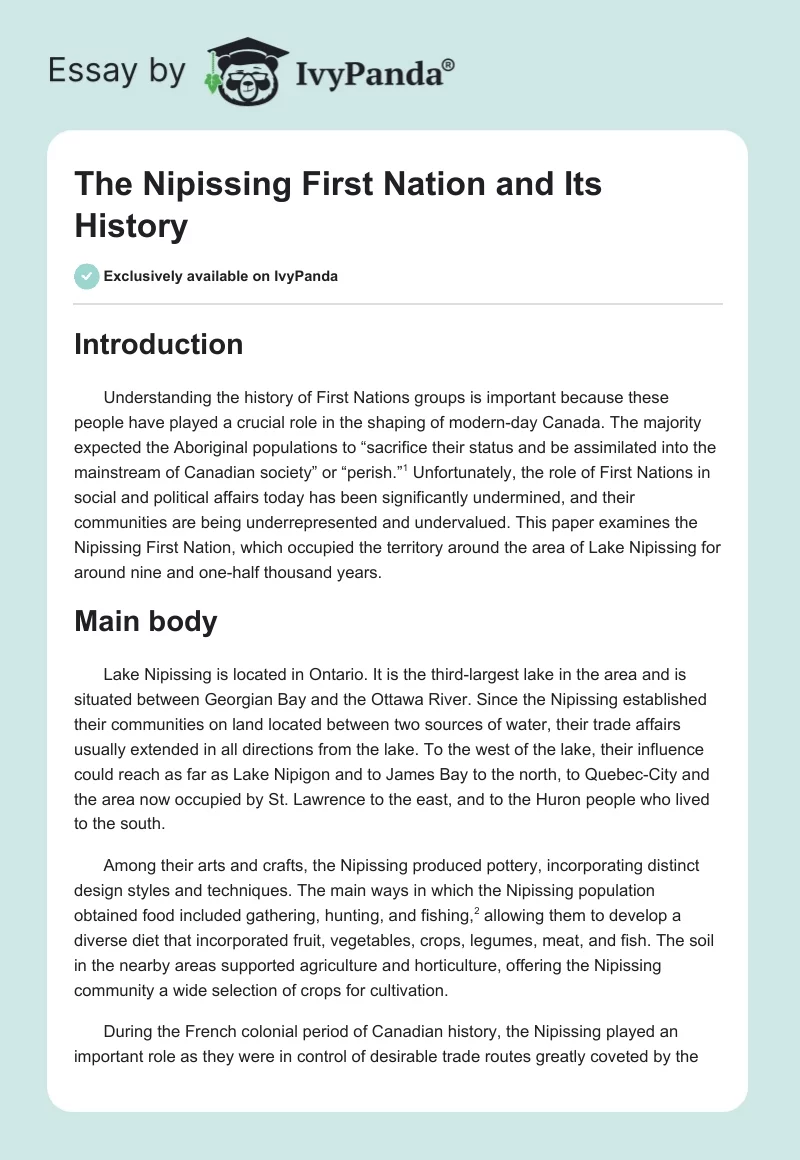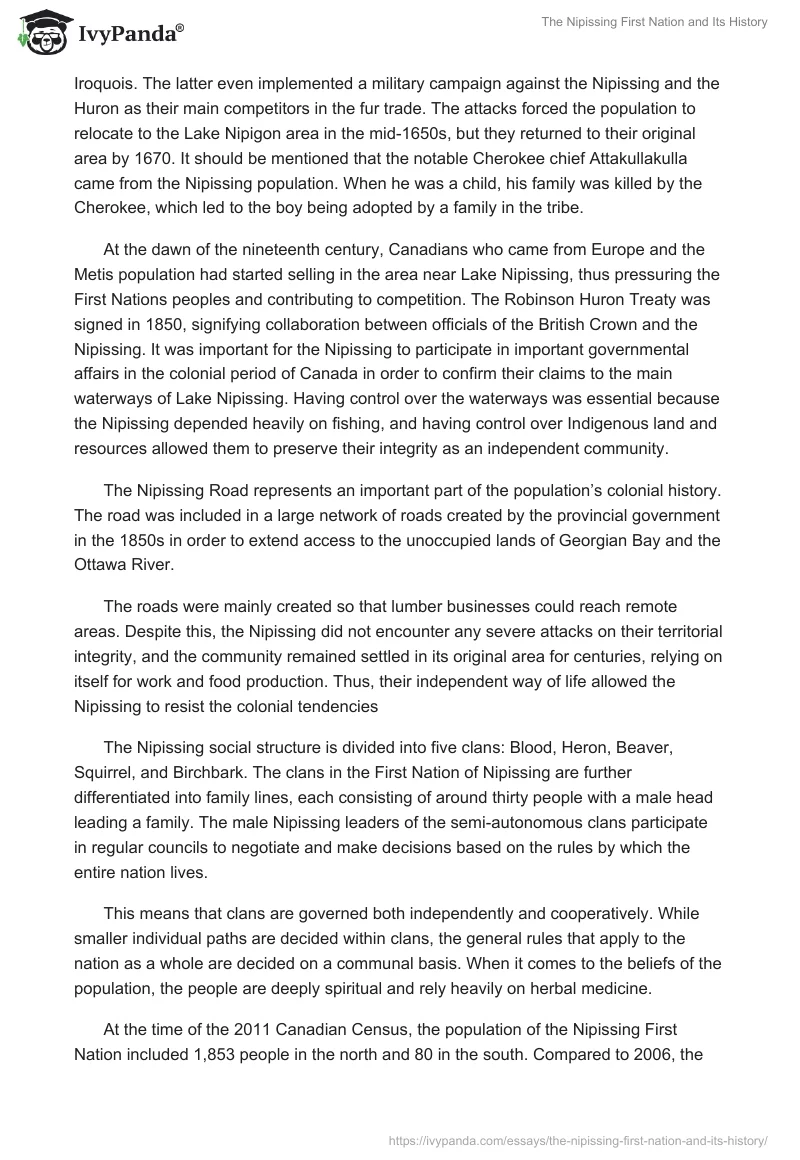Introduction
Understanding the history of First Nations groups is important because these people have played a crucial role in the shaping of modern-day Canada. The majority expected the Aboriginal populations to “sacrifice their status and be assimilated into the mainstream of Canadian society” or “perish.” Unfortunately, the role of First Nations in social and political affairs today has been significantly undermined, and their communities are being underrepresented and undervalued. This paper examines the Nipissing First Nation, which occupied the territory around the area of Lake Nipissing for around nine and one-half thousand years.
Main body
Lake Nipissing is located in Ontario. It is the third-largest lake in the area and is situated between Georgian Bay and the Ottawa River. Since the Nipissing established their communities on land located between two sources of water, their trade affairs usually extended in all directions from the lake. To the west of the lake, their influence could reach as far as Lake Nipigon and to James Bay to the north, to Quebec-City and the area now occupied by St. Lawrence to the east, and to the Huron people who lived to the south.
Among their arts and crafts, the Nipissing produced pottery, incorporating distinct design styles and techniques. The main ways in which the Nipissing population obtained food included gathering, hunting, and fishing, allowing them to develop a diverse diet that incorporated fruit, vegetables, crops, legumes, meat, and fish. The soil in the nearby areas supported agriculture and horticulture, offering the Nipissing community a wide selection of crops for cultivation.
During the French colonial period of Canadian history, the Nipissing played an important role as they were in control of desirable trade routes greatly coveted by the Iroquois. The latter even implemented a military campaign against the Nipissing and the Huron as their main competitors in the fur trade. The attacks forced the population to relocate to the Lake Nipigon area in the mid-1650s, but they returned to their original area by 1670. It should be mentioned that the notable Cherokee chief Attakullakulla came from the Nipissing population. When he was a child, his family was killed by the Cherokee, which led to the boy being adopted by a family in the tribe.
At the dawn of the nineteenth century, Canadians who came from Europe and the Metis population had started selling in the area near Lake Nipissing, thus pressuring the First Nations peoples and contributing to competition. The Robinson Huron Treaty was signed in 1850, signifying collaboration between officials of the British Crown and the Nipissing. It was important for the Nipissing to participate in important governmental affairs in the colonial period of Canada in order to confirm their claims to the main waterways of Lake Nipissing. Having control over the waterways was essential because the Nipissing depended heavily on fishing, and having control over Indigenous land and resources allowed them to preserve their integrity as an independent community.
The Nipissing Road represents an important part of the population’s colonial history. The road was included in a large network of roads created by the provincial government in the 1850s in order to extend access to the unoccupied lands of Georgian Bay and the Ottawa River.
The roads were mainly created so that lumber businesses could reach remote areas. Despite this, the Nipissing did not encounter any severe attacks on their territorial integrity, and the community remained settled in its original area for centuries, relying on itself for work and food production. Thus, their independent way of life allowed the Nipissing to resist the colonial tendencies
The Nipissing social structure is divided into five clans: Blood, Heron, Beaver, Squirrel, and Birchbark. The clans in the First Nation of Nipissing are further differentiated into family lines, each consisting of around thirty people with a male head leading a family. The male Nipissing leaders of the semi-autonomous clans participate in regular councils to negotiate and make decisions based on the rules by which the entire nation lives.
This means that clans are governed both independently and cooperatively. While smaller individual paths are decided within clans, the general rules that apply to the nation as a whole are decided on a communal basis. When it comes to the beliefs of the population, the people are deeply spiritual and rely heavily on herbal medicine.
At the time of the 2011 Canadian Census, the population of the Nipissing First Nation included 1,853 people in the north and 80 in the south. Compared to 2006, the southern section of the population decreased by 86%, while in the north, it increased by 3.1%. The median age of the population is 48.1 years, with 85.9% of people aged 15 and older. Of those identified as Nipissing, 1,050 are married or live with a common-law partner; the total number of families residing in private households is 585. The population speaks English, French, and the Nipissing Ojibwe dialect.
Conclusion
The Nipissing governance system includes a chief, deputy chief, and six councilors. Currently, Scott McLeod is the chief, Muriel Sawyer is the deputy chief, and Rick Stevens, June Commanda, Corey Coulais, Brian Couchie, Mike Sawyer, and Jane Commanda constitute the council members. In conclusion, it should be mentioned that the Nipissing established their own constitution several years ago, which replaced the Indian Act.
Bibliography
Belshaw, John Douglas. Canadian History: Post-Confederation. Ontario: Creative Commons, 2012.
Bishop, Charles. Eastern Woodlands Indigenous Peoples in Canada. Web.
Nipissing First Nation. Council Members. Web.
Statistics Canada. Census Profile. Web.


